A ‘Ring Of Fire’ Solar Eclipse Is A Rare Phenomenon That Occurs When The Moon’s Orbit Is At Its


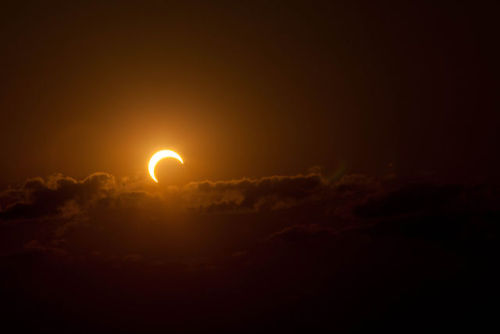

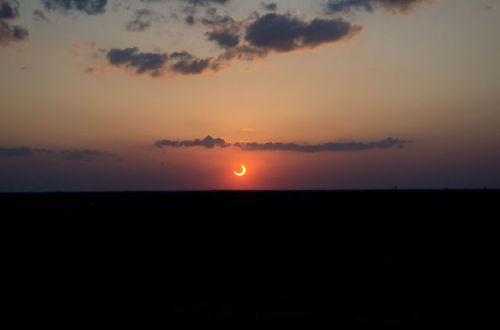


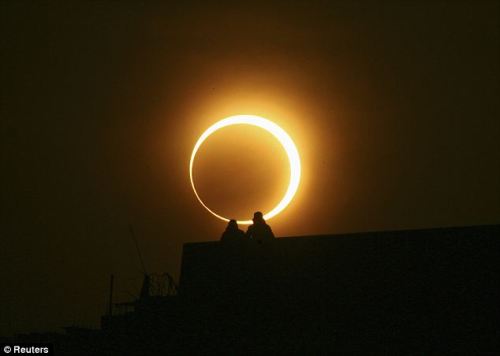
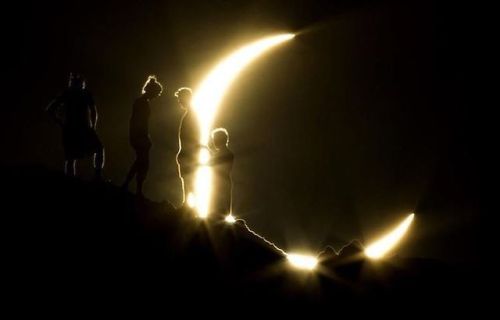
A ‘Ring of Fire’ solar eclipse is a rare phenomenon that occurs when the moon’s orbit is at its apogee: the part of its orbit farthest away from the Earth. Because the moon is so far away, it seems smaller than normal to the human eye. The result is that the moon doesn't entirely block out our view of the sun, but leaves an “annulus,” or ring of sunlight glowing around it. Hence the term “annular” eclipse rather than a “total” eclipse.
More Posts from Fillthevoid-with-space and Others

(I broke the last link, whoops)
Another week of theory, but no fun new particles. Instead, hear me try to say a lot of names of scientists or their eponymous equations as I talk about dark energy in the universe! Learn what some astronomers think it is and why other astronomers think there are better explanations for certain nutty galactic phenomena.
Below the cut are my sources, music credits, a vocab list, and the transcript of this episode. Let your voice be heard and tell me what you think I should research next by messaging me here, tweeting at me at @HDandtheVoid, or asking me to my face if you know me in real life. And please subscribe to the podcast on iTunes, rate it and maybe review it, and tell friends if you think they’d like to listen!
(If anything about dark matter or dark energy or cosmic microwave background radiation confused you over the past few podcasts, for sure send me your questions so I can ask someone more qualified than me—my doctorate student friend! My thoughts on the next episode are still the Voyager golden records, space race history, the transit of Venus, the Moon landing, Edmond Halley, or Dark Sky Preserves and it will be up on November 20th.)
Glossary
baryons - heaviest particles. Ex. Protons, neutrons. In astroparticle physics, electrons are included in baryonic matter.
cosmic microwave background radiation - the electromagnetic radiation left over from the time of recombination in Big Bang cosmology.
dark energy - a theoretical force made up of unknown, undetectable energy. It is used to explain why the universe is expanding more rapidly over time instead of slowing its expansion.
dark matter - a theoretical mass made up of unknown particles that have not been created on Earth. It is used to explain why galaxy clusters have 10x the mass that their light output suggests they would have; why distant stars on the edges of spiral galaxies orbit at the same speed as stars near the center of the galaxy; and the accretion of gases that created galaxies at the beginning of the universe.
fundamental forces - four fundamental forces in our current model of the universe: the strong and weak nuclear forces, the electromagnetic force, and gravity.
gravitational lensing - when light from more distant sources passes near a massive star, galaxy, or galaxy cluster and the object’s gravity bends the light like a lens to provide a warped angle view of space.
Transcript
Sources
Dark energy via NASA
Dark energy via Hubble
“The strangeness of dark energy is thrilling.”
Fundamental forces via Georgia State University
Dark energy via Science Magazine (April 2017)
László Dobos: “We assume that every region of the universe determines its expansion rate itself.”
Dark energy and the South Pole Telescope via Smithsonian Magazine (April 2010)
“Knowing what dark matter is would help scientists think about how the structure of the universe forms. Knowing what dark energy does would help scientists think about how that structure has evolved over time—and how it will continue to evolve.”
Intro Music: ‘Better Times Will Come’ by No Luck Club off their album Prosperity
Filler Music: ‘Even The Darkness Has Arms’ by The Barr Brothers off their album The Sleeping Operator
Outro Music: ‘Fields of Russia’ by Mutefish off their album On Draught
Spacewalkers Successfully Connect Adapter for Commercial Crew Vehicles
ISS - Expedition 50 Mission patch / EVA - Extra Vehicular Activities patch. March 30, 2017 Expedition 50 Commander Shane Kimbrough and Flight Engineer Peggy Whitson of NASA concluded their spacewalk at 2:33 p.m. EDT. During the spacewalk, which lasted just over seven hours, the two astronauts successfully reconnected cables and electrical connections on the Pressurized Mating Adapter-3. PMA-3 will provide the pressurized interface between the station and the second of two international docking adapters to be delivered to the complex to support the dockings of U.S. commercial crew spacecraft in the future.
Image above: Spacewalkers Shane Kimbrough (spacesuit with red stripe on legs) and Peggy Whitson are pictured shortly after exiting the Quest airlock this morning. Image Credits: @Thom_Astro. The duo were also tasked with installing four thermal protection shields on the Tranquility module of the International Space Station. The shields were required to cover the port where the PMA-3 was removed earlier in the week and robotically installed on the Harmony module. During the spacewalk, one of the shields was inadvertently lost. The loss posed no immediate danger to the astronauts and Kimbrough and Whitson went on to successfully install the remaining shields on the common berthing mechanism port. A team from the Mission Control Center at NASA’s Johnson Space Center in Houston devised a plan for the astronauts to finish covering the port with the PMA-3 cover Whitson removed earlier in the day. The plan worked, and the cover was successfully installed, providing thermal protection and micrometeoroid and orbital debris cover for the port. To round out the spacewalk, Kimbrough and Whitson also installed a different shield around the base of the PMA-3 adapter for micrometeoroid protection. The shield was nicknamed a cummerbund as it fits around the adapter similar to a tuxedo’s cummerbund worn around the waist.
Image above: Astronaut Peggy Whitson signs her autograph near an Expedition 50 mission patch attached to the inside the International Space Station. Image Credit: NASA. Having completed her eighth spacewalk, Whitson now holds the record for the most spacewalks and accumulated time spacewalking by a female astronaut. Spacewalkers have now spent a total of 1,243 hours and 42 minutes outside the station during 199 spacewalks in support of assembly and maintenance of the orbiting laboratory. Related links: International docking adapters: https://www.nasa.gov/feature/meet-the-international-docking-adapter Peggy Whitson spacewalk record: https://blogs.nasa.gov/spacestation/2017/03/29/astronaut-peggy-whitson-set-to-break-spacewalk-record-thursday/ Space Station Research and Technology: https://www.nasa.gov/mission_pages/station/research/index.html International Space Station (ISS): https://www.nasa.gov/mission_pages/station/main/index.html Images (mentioned), Text, Credits: NASA/Mark Garcia. Best regards, Orbiter.ch Full article

Spacewalk complete and new astronaut record set! Shane Kimbrough and Peggy Whitson of NASA successfully reconnected cables and electrical connections on an adapter-3 that will provide the pressurized interface between the station and the second of two international docking adapters to be delivered to the complex to support the dockings of U.S. commercial crew spacecraft in the future. The duo were also tasked with installing four thermal protection shields on the Tranquility module of the International Space Station.
Having completed her eighth spacewalk, Whitson now holds the record for the most spacewalks and accumulated time spacewalking by a female astronaut. Spacewalkers have now spent a total of 1,243 hours and 42 minutes outside the station during 199 spacewalks in support of assembly and maintenance of the orbiting laboratory.
Astronaut Thomas Pesquet of ESA posted this image and wrote, ’ Shane and Peggy on their way to their first #spacewalk tasks.’
Credit: ESA/NASA

sun depicted as a divinity petroglyph on the plateau Yagour (High Atlas mountains), Morocco.. 6000 to 8000 BC
SpaceX SES-10 Mission successfully Launch
SpaceX - Falcon 9 / SES-10 Mission patch. March 31, 2017
Falcon 9 carrying SES-10 satellite launch
SpaceX took a step into the future Thursday as it reused – for the first time – a recovered first stage of a previously-flown Falcon 9 rocket. Thursday’s mission, carrying the SES-10 communications satellite, lifted off from Pad 39A at Florida’s Kennedy Space Center Thursday 30 March at 18:27 local time (22:27 UTC) and once again landed the booster.
Falcon 9 launch of SES-10
Thursday’s mission made use Falcon 9 the second orbit-capable rocket – after the Space Shuttle – to achieve partial reusability. The Falcon 9 flew from Launch Complex 39A at the Kennedy Space Center, the same pad from which the Shuttle began eighty-two of its missions, including its first and final flights. Reusability has long been a key objective for SpaceX. Making the company’s first launch in March 2006, the small Falcon 1 vehicle carried a parachute system intended to bring its spent first stage back to Earth.
Falcon 9 first stage landed on drone barge
SpaceX’s Falcon 9 rocket deliver SES-10, a commercial communications satellite for SES, to a Geostationary Transfer Orbit (GTO). SES is a world-leading satellite operator, providing reliable and secure satellite communications solutions across the globe.
SES-10 satellite
The SES-10 mission mark a historic milestone on the road to full and rapid reusability as the world’s first reflight of an orbital class rocket. Falcon 9’s first stage for the SES-10 mission previously supported the successful CRS-8 mission in April 2016. For more information about SpaceX, visit: http://www.spacex.com/ Images, Video, Text, Credits: SpaceX/SES. Greetings, Orbiter.ch Full article
Solar System: Things to Know This Week
Like sailors of old, the Cassini mission team fondly thinks of the spacecraft as “she." On April 22, she begins her Grand Finale, a spectacular end game—22 daring dives between the planet’s atmosphere and innermost rings. Here are 10 things to know about her Grand Finale.

1. She’s Broadcasting Live This Week
On Tuesday, April 4 at 3 p.m. EDT (noon PDT), At Jet Propulsion Laboratory, the Cassini team host a news briefing to discuss the mission’s Grand Finale.
Tune in Tuesday: youtube.com/nasajpl/live

2. She’s Powered in Part By … Titan
Cassini left Earth with less than 1/30th of the propellant needed to power all her adventures at Saturn. The navigation team used the gravity of Saturn’s giant moon Titan to change course and extend the spacecraft’s exploration of Saturn. Titan also provides the gravity assist to push Cassini into its final orbits.
More on Cassini’s navigation: saturn.jpl.nasa.gov/mission/spacecraft/navigation/

3. She’s a Robot
Cassini is an orbiter that was named for 18th century astronomer Giovanni Domenico Cassini. She was designed to be captured by Saturn’s gravity and then explore it in detail with a suite of 12 powerful science instruments.
More on the Spacecraft: saturn.jpl.nasa.gov/mission/spacecraft/cassini-orbiter/

4. She Brought a Friend to Saturn
Cassini carried the European Space Agency’s Huygens Probe, which in 2005 descended through Titan’s thick, perpetual clouds and made the most distant landing to date in our solar system.
More on Huygens: saturn.jpl.nasa.gov/mission/spacecraft/huygens-probe/

5. She’s a Great Photographer
Your mobile phone likely captures dozens of megapixels in images. Cassini, using 1990s technology closer to one megapixel cameras, has returned some of the most stunning images in the history of solar system exploration.
Cassini Hall of Fame Images: go.nasa.gov/2oec6H2 More on Cassini’s Cameras: saturn.jpl.nasa.gov/imaging-science-subsystem/

6. She’s an Inspiration
Those great images have inspired artist’s and amateur image processors to create truly fantastic imagery inspired by the beauty of Saturn. Feeling inspired? There’s still time to share your Cassini-inspired art with us.
Cassini Inspires Campaign: saturn.jpl.nasa.gov/mission/cassiniinspires/

7. She’s Got a Long History
Two decades is a long time to live in the harsh environment of outer space (respect to the fast-approaching 40-year-old twin Voyager spacecraft). Launched in 1997, Cassini logged a lot of milestones over the years.
Explore the Cassini Timeline: saturn.jpl.nasa.gov/the-journey/timeline/

8. She Keeps a Diary
And, you can read it. Week after week going back to 1997, Cassini’s adventures, discoveries and status have been chronicled in the mission’s weekly significant events report.
Read It: https://saturn.jpl.nasa.gov/news/?topic=121

9. She’s Got a Fancy New App
Cassini was the prototype for NASA’s Eyes on the Solar System 3-D visualization software, so it’s fitting the latest Cassini module in the free, downloadable software is the most detailed, elaborate visualization of any mission to date.
Fly the Mission - Start to Finish: http://eyes.nasa.gov/cassini

10. She’s Going Out in a Blaze of Glory
In addition to all the new information from 22 orbits in unexplored space, Cassini’s engineers reprogrammed the spacecraft to send back details about Saturn’s atmosphere to the very last second before the giant planet swallows her up on Sept. 15, 2017.
More on the Grand Finale: saturn.jpl.nasa.gov/grandfinale
Discover more lists of 10 things to know about our solar system HERE.
Make sure to follow us on Tumblr for your regular dose of space: http://nasa.tumblr.com

When I was in Ireland in 2013, I kept seeing signs for ‘quasar.’ I finally learned that it’s the European way of saying laser tag. It has nothing to do with quasars, which are a specific type of a specific type of galaxy. Listen to this week’s (pretty short) podcast on two types of active galaxies: quasars and blazars.
Below the cut, I have the transcript, sources, music credits, and timeline of people I talked about! If you have suggestions for topics I could cover, please send me a Tumblr message or tweet at me on Twitter at @HDandtheVoid, or you can ask me to my face if you know me. Please subscribe on iTunes, rate my podcast and maybe review it, and tell friends if you think they’d like to hear it!
(My thoughts on the next episode are the SOFIA observatory, Chuck Yaeger, or the great Stephen Hawking. The next episode will go up April 2nd.)
Glossary
active galaxy or active galactic nucleus- a galaxy with a small core of emission embedded at the center. This core is typically very variable and very bright compared to the rest of the galaxy. These galaxies emit much more energy than they should; this excess energy is found in the infrared, radio, UV, and X-ray regions of the electromagnetic spectrum.
blazar - a subcategory of active galaxy, it is an extremely bright, distant object, powered by a black hole, which emits massive amounts of energy. It is distinct from a quasar because it is even brighter.
extragalactic objects - objects outside our Milky Way galaxy.
interferometry - a group of techniques to extract information from superimposing electromagnetic waves to create interference. In radio astronomy, this is done by using a wide spread of receivers to look at the same distant object, then bringing that data together with a correlator that can create a larger, clearer picture than an individual radio telescope alone could.
lunar occultations - when stars pass behind the Moon. This is the basis for a method of determining and mapping star positions.
quasar - a subcategory of active galaxy, it is an extremely bright, distant object, powered by a black hole, which emits massive amounts of energy. It is distinct from a blazar because it is less-bright. The name is a contraction of “quasi-stellar radio source” (which is not necessarily true of all quasars—90% are radio-quiet).
torus - a donut shape.
Script/Transcript
Timeline
Walter Baade, German (1893-1960)
Rudolph Minkowski, German-American (1895-1976)
Fritz Zwicky, Swiss (1898-1974)
Gordon Stanley, New Zealander (1921-2001)
John Bolton, English-Australian (1922-1993)
Owen Bruce Slee, Australian (1924-2016)
Allan Rex Sandage, American (1926-2010)
Cyril Hazard, English (1928- )
Maartin Schmidt, Dutch (1929- )
Hong-Yee Chiu, American (1932- )
Stephen Hawking, English (1942 -2018)
Jedidah Isler
Sources
Active Galaxies via NASA (Dec 2016)
Galaxy shapes via Cornell University (April 2000)
Galaxies and Black Holes by David Merritt, published on NED by Caltech and NASA
Cyril Hazard via University of Pittsburgh
The Discovery of Quasars and its Aftermath via Journal of Astronomical History and Heritage (2014)
“Characteristically, Fritz Zwicky (1898–1974; Figure 11) immediately pointed out that ‘All of the five quasi-stellar galaxies described individually by Sandage (1965) evidently belong to the subclass of compact galaxies with pure emission spectra previously discovered and described by the present writer. (Zwicky, 1965: 1293).’ A few years later, Zwicky was less circumspect and wrote: ‘In spite of all these facts being known to him in 1964, Sandage attempted one of the most astounding feats of plagiarism by announcing the existence of a major new component of the Universe: the quasi-stellar galaxies ... Sandage‘s earthshaking discovery consisted in nothing more than renaming compact galaxies, calling them ‘interlopers‘ and quasistellar galaxies, thus playing the interloper himself. (Zwicky and Zwicky, 1971: xix)’”
Lunar occultations via Sky and Telescope
Quasars and Blazars by Matthew Whiting (a chapter in his thesis, What made the quasar blush? Emission mechanisms in optically-red quasars) via the Australia Telescope National Facility (2000)
Jedidah Isler on quasars and blazars via TED Talks (March 2015)
Quasar definition via Space.com (Feb 2018)
Intro Music: ‘Better Times Will Come’ by No Luck Club off their album Prosperity
Filler Music: ‘Into The White’ by Pixies off their album Wave of Mutilation.
Outro Music: ‘Fields of Russia’ by Mutefish off their album On Draught

In the Heart of the Virgo Cluster : The Virgo Cluster of Galaxies is the closest cluster of galaxies to our Milky Way Galaxy. The Virgo Cluster is so close that it spans more than 5 degrees on the sky - about 10 times the angle made by a full Moon. With its heart lying about 70 million light years distant, the Virgo Cluster is the nearest cluster of galaxies, contains over 2,000 galaxies, and has a noticeable gravitational pull on the galaxies of the Local Group of Galaxies surrounding our Milky Way Galaxy. The cluster contains not only galaxies filled with stars but also gas so hot it glows in X-rays. Motions of galaxies in and around clusters indicate that they contain more dark matter than any visible matter we can see. Pictured above, the heart of the Virgo Cluster includes bright Messier galaxies such as Markarians Eyes on the upper left, M86 just to the upper right of center, M84 on the far right, as well as spiral galaxy NGC 4388 at the bottom right. via NASA
js

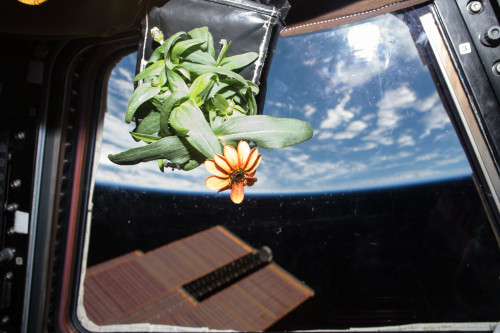

Take a moment, look outside your window. 🌷🌼
Today is the #FirstDayOfSpring in the Northern Hemisphere, also known as the vernal equinox.
#DYK Earth’s tilted axis causes the season? Throughout the year, different parts of Earth receive the Sun’s most direct rays. So, when the North Pole tilts toward the Sun, it’s summer in the Northern Hemisphere. And when the South Pole tilts toward the Sun, it’s winter in the Northern Hemisphere.
These images are of Zinnias. They are part of the flowering crop experiment that began aboard the International Space Station on Nov. 16, 2015, when NASA astronaut Kjell Lindgren activated the Veggie system and its rooting “pillows” containing zinnia seeds.
Make sure to follow us on Tumblr for your regular dose of space: http://nasa.tumblr.com.
-
 salenasw liked this · 2 weeks ago
salenasw liked this · 2 weeks ago -
 catlizard reblogged this · 1 month ago
catlizard reblogged this · 1 month ago -
 catlizard liked this · 1 month ago
catlizard liked this · 1 month ago -
 wolfifi52 reblogged this · 1 month ago
wolfifi52 reblogged this · 1 month ago -
 temporalschism liked this · 1 month ago
temporalschism liked this · 1 month ago -
 skittlez2932 reblogged this · 1 month ago
skittlez2932 reblogged this · 1 month ago -
 emocionalno-nedostupan liked this · 1 month ago
emocionalno-nedostupan liked this · 1 month ago -
 alisasacagawea reblogged this · 1 month ago
alisasacagawea reblogged this · 1 month ago -
 alisasacagawea liked this · 1 month ago
alisasacagawea liked this · 1 month ago -
 awarriorhomefromthehills2 liked this · 1 month ago
awarriorhomefromthehills2 liked this · 1 month ago -
 holycrapitis liked this · 2 months ago
holycrapitis liked this · 2 months ago -
 myhickory1930 reblogged this · 2 months ago
myhickory1930 reblogged this · 2 months ago -
 jokerpilot liked this · 2 months ago
jokerpilot liked this · 2 months ago -
 ldienne liked this · 2 months ago
ldienne liked this · 2 months ago -
 the-piligrim-stuff liked this · 2 months ago
the-piligrim-stuff liked this · 2 months ago -
 freeusebiker liked this · 2 months ago
freeusebiker liked this · 2 months ago -
 chibimats reblogged this · 2 months ago
chibimats reblogged this · 2 months ago -
 chibimats liked this · 2 months ago
chibimats liked this · 2 months ago -
 krinsbez liked this · 2 months ago
krinsbez liked this · 2 months ago -
 astat3ofgrac3 reblogged this · 2 months ago
astat3ofgrac3 reblogged this · 2 months ago -
 importantmentalityphilosopher liked this · 2 months ago
importantmentalityphilosopher liked this · 2 months ago -
 baltic-anchorite reblogged this · 2 months ago
baltic-anchorite reblogged this · 2 months ago -
 navyht3 liked this · 2 months ago
navyht3 liked this · 2 months ago -
 kojiarakiartworks liked this · 2 months ago
kojiarakiartworks liked this · 2 months ago -
 leatherneck1983 reblogged this · 2 months ago
leatherneck1983 reblogged this · 2 months ago -
 ffxiv-swarm reblogged this · 2 months ago
ffxiv-swarm reblogged this · 2 months ago -
 leextacy liked this · 2 months ago
leextacy liked this · 2 months ago -
 50fottutesfumaturedisangue liked this · 2 months ago
50fottutesfumaturedisangue liked this · 2 months ago -
 t-nightingale reblogged this · 2 months ago
t-nightingale reblogged this · 2 months ago -
 ix-uar-144 liked this · 2 months ago
ix-uar-144 liked this · 2 months ago -
 teddygyuu liked this · 2 months ago
teddygyuu liked this · 2 months ago -
 arsenictheskully liked this · 3 months ago
arsenictheskully liked this · 3 months ago -
 wandering-cynic reblogged this · 3 months ago
wandering-cynic reblogged this · 3 months ago -
 beigewonderland liked this · 3 months ago
beigewonderland liked this · 3 months ago -
 hailsatanthemost liked this · 3 months ago
hailsatanthemost liked this · 3 months ago -
 shannybangbang reblogged this · 3 months ago
shannybangbang reblogged this · 3 months ago -
 saucegotti liked this · 3 months ago
saucegotti liked this · 3 months ago -
 f-drko reblogged this · 3 months ago
f-drko reblogged this · 3 months ago -
 reblogagainandagain reblogged this · 3 months ago
reblogagainandagain reblogged this · 3 months ago -
 reblogagainandagain liked this · 3 months ago
reblogagainandagain liked this · 3 months ago -
 curiokhan0113 liked this · 3 months ago
curiokhan0113 liked this · 3 months ago -
 professionalbadexample reblogged this · 3 months ago
professionalbadexample reblogged this · 3 months ago -
 ofthalmoloutro2 liked this · 3 months ago
ofthalmoloutro2 liked this · 3 months ago -
 beyourself2020 liked this · 3 months ago
beyourself2020 liked this · 3 months ago
A podcast project to fill the space in my heart and my time that used to be filled with academic research. In 2018, that space gets filled with... MORE SPACE! Cheerfully researched, painstakingly edited, informal as hell, definitely worth everyone's time.
243 posts
